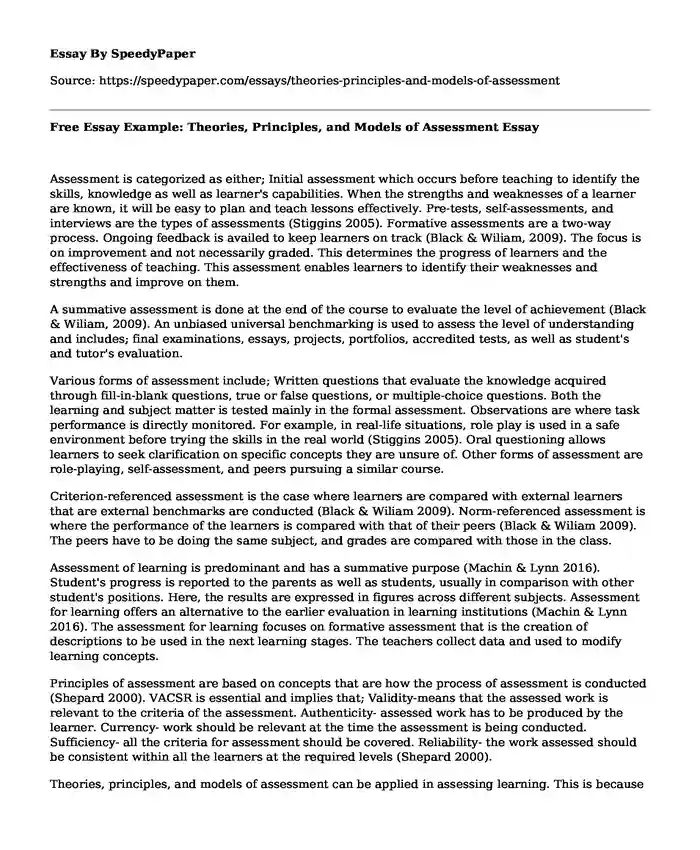
| Type of paper: | Essay |
| Categories: | Teaching Knowledge Students Nursing care |
| Pages: | 3 |
| Wordcount: | 657 words |
Assessment is categorized as either; Initial assessment which occurs before teaching to identify the skills, knowledge as well as learner's capabilities. When the strengths and weaknesses of a learner are known, it will be easy to plan and teach lessons effectively. Pre-tests, self-assessments, and interviews are the types of assessments (Stiggins 2005). Formative assessments are a two-way process. Ongoing feedback is availed to keep learners on track (Black & Wiliam, 2009). The focus is on improvement and not necessarily graded. This determines the progress of learners and the effectiveness of teaching. This assessment enables learners to identify their weaknesses and strengths and improve on them.
A summative assessment is done at the end of the course to evaluate the level of achievement (Black & Wiliam, 2009). An unbiased universal benchmarking is used to assess the level of understanding and includes; final examinations, essays, projects, portfolios, accredited tests, as well as student's and tutor's evaluation.
Various forms of assessment include; Written questions that evaluate the knowledge acquired through fill-in-blank questions, true or false questions, or multiple-choice questions. Both the learning and subject matter is tested mainly in the formal assessment. Observations are where task performance is directly monitored. For example, in real-life situations, role play is used in a safe environment before trying the skills in the real world (Stiggins 2005). Oral questioning allows learners to seek clarification on specific concepts they are unsure of. Other forms of assessment are role-playing, self-assessment, and peers pursuing a similar course.
Criterion-referenced assessment is the case where learners are compared with external learners that are external benchmarks are conducted (Black & Wiliam 2009). Norm-referenced assessment is where the performance of the learners is compared with that of their peers (Black & Wiliam 2009). The peers have to be doing the same subject, and grades are compared with those in the class.
Assessment of learning is predominant and has a summative purpose (Machin & Lynn 2016). Student's progress is reported to the parents as well as students, usually in comparison with other student's positions. Here, the results are expressed in figures across different subjects. Assessment for learning offers an alternative to the earlier evaluation in learning institutions (Machin & Lynn 2016). The assessment for learning focuses on formative assessment that is the creation of descriptions to be used in the next learning stages. The teachers collect data and used to modify learning concepts.
Principles of assessment are based on concepts that are how the process of assessment is conducted (Shepard 2000). VACSR is essential and implies that; Validity-means that the assessed work is relevant to the criteria of the assessment. Authenticity- assessed work has to be produced by the learner. Currency- work should be relevant at the time the assessment is being conducted. Sufficiency- all the criteria for assessment should be covered. Reliability- the work assessed should be consistent within all the learners at the required levels (Shepard 2000).
Theories, principles, and models of assessment can be applied in assessing learning. This is because the different models assist in developing and applying the assessments (Wilson 2014). In frail care nursing in nursing home teaching when training nurses, these principles and assessment models are essential in the application. The assessment type selected is influenced by actual role assessment. The learner's ability in the nursing care home can be judged and used to evaluate their progress. Formative assessment will evaluate the progress of the whole nursing course. A summative assessment will be applied at the end of the course (Wilson 2014). These assessments are then compared with the pre-assessments to provide the evidence of change.
Bibliography
Black, P., and Wiliam, D., 2009. Developing the theory of formative assessment. Educational Assessment, Evaluation, and Accountability (formerly: Journal of Personnel Evaluation in Education), 21(1), p.5.
Machin, Lynn (2016) A Complete Guide to the Level 5 Diploma in Education and Training. UK: Critical Publishing (2nd edition)
Shepard, L.A., 2000. The role of assessment in a learning culture. Educational researcher, 29(7), pp.4-14.
Stiggins, R.J., 2005. Student-involved assessment for learning.
Wilson, L., 2014. Practical Teaching. Cengage Textbooks.
Cite this page
Free Essay Example: Theories, Principles, and Models of Assessment. (2023, Feb 12). Retrieved from https://speedypaper.net/essays/theories-principles-and-models-of-assessment
Request Removal
If you are the original author of this essay and no longer wish to have it published on the SpeedyPaper website, please click below to request its removal:
- Essay Example on the American Social Classes
- Essay Example on the Role of Civility in Sustaining Democracy
- Free Essay Example on Product Disassembly
- Essay Example: The Traditional View of the Family in Singapore
- Birmingham Letters - Rhetorical Analysis Essay Sample
- Essay Example on Resilience in the Workplace
- Paper Example: Characteristics of a Technical Document
Popular categories




